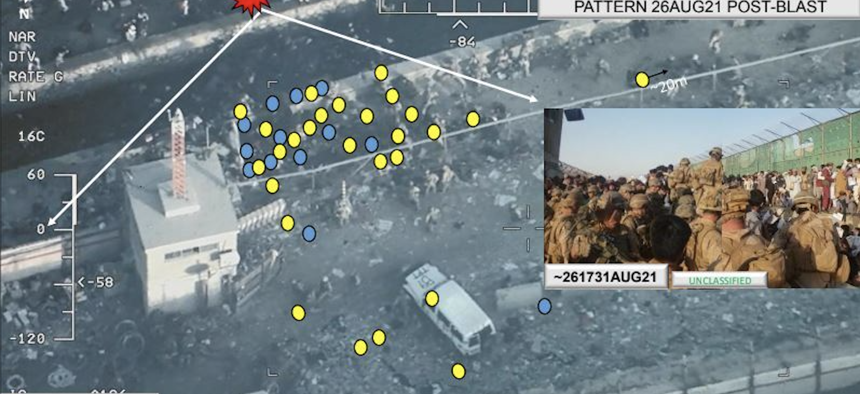Kabul Suicide Bomber Likely Acted Without Taliban Aid, CENTCOM Concludes
Command wraps investigation in airport blast that killed 13 during Afghanistan evacuation.
Just before a deadly blast killed 13 U.S. service members and 170 Afghan civilians near the Kabul airport on Aug. 26, a figure dressed in black advanced along a nearby canal filled with desperate civilians, a new Department of Defense video released Friday showed.
Seconds later, ball bearings ripped through the people nearby, killing even U.S. troops whose torsos were protected by body armor. Shock waves inflicted harm on others up to a half a football field away, wounding another 45 service members.
“Within seconds of the blast, Marines experienced mental and physical friction,” said U.S. Marine Corps Col. C.J. Douglas, one of the investigators. “Mentally, they worked through the uncertainty of what had just occurred, and the possibility that Taliban could be responsible. Very quickly, Marines determine the Taliban are neither involved nor threatening U.S. personnel.”
The ball bearings pierced canisters of tear gas carried by Marines, disorienting them further, Douglas said.
The bombing near Hamid Karzai International Airport’s Abbey Gate, in the final days of the U.S. evacuation, was the deadliest attack on U.S. troops in the country in years. In the days and weeks that followed, lawmakers wondered how a bomber could have gotten so close, whether Taliban were complicit in letting the bomber through, and why Abbey Gate wasn’t closed sooner.
On Friday, U.S. Central Command released its final investigation into the attack, along with several related videos. The inquest concluded that this single bomber acted alone, that there were no follow-on attacks, and that there were no wounds from subsequent gunfire. In each case, early U.S. assessments of the attack had concluded the opposite..
It also revealed that British, U.S., and Taliban representatives had discussed closing Abbey Gate at a meeting just 36 minutes before the blast.
The gate was left open because there were still people outside the gate whom U.S. and coalition forces were trying to get into the airport.
The area was crammed with Afghans trying to get through and Marines who were conducting body screenings on each person allowed in.
Just a day before, a Marine had been pulled into the crowd when one of the Afghans grabbed the muzzle of his gun, according to another video CENTCOM released Friday. That incident resulted in more troops—but not more barriers—being sent to reinforce the wall, which meant more service members were exposed to the blast.
“Part of the reason that there were no additional barriers or constraints had to do with the fact that they were actively pulling potential evacuees from the crowd, which included American citizens and others. So, again, they had to have access to the crowd, and they had to have close personal contact with those that they were trying to move,” Curtis said.
Investigators concluded that the bomber likely used one of the back alleys and sewage canal paths to get to the gate and bypass Taliban checkpoints. After the Taliban began limiting who could get through its checkpoints, Afghans began finding smaller cut-throughs to get into the complex.
On Friday, investigators were asked whether the Taliban knew at that meeting that a bomber was on the way.
“We don't have any evidence for the course of our investigation that leads us to believe that the Taliban knew about this attack,” said Army Brig. Gen. Lance Curtis, one of the lead investigators.





